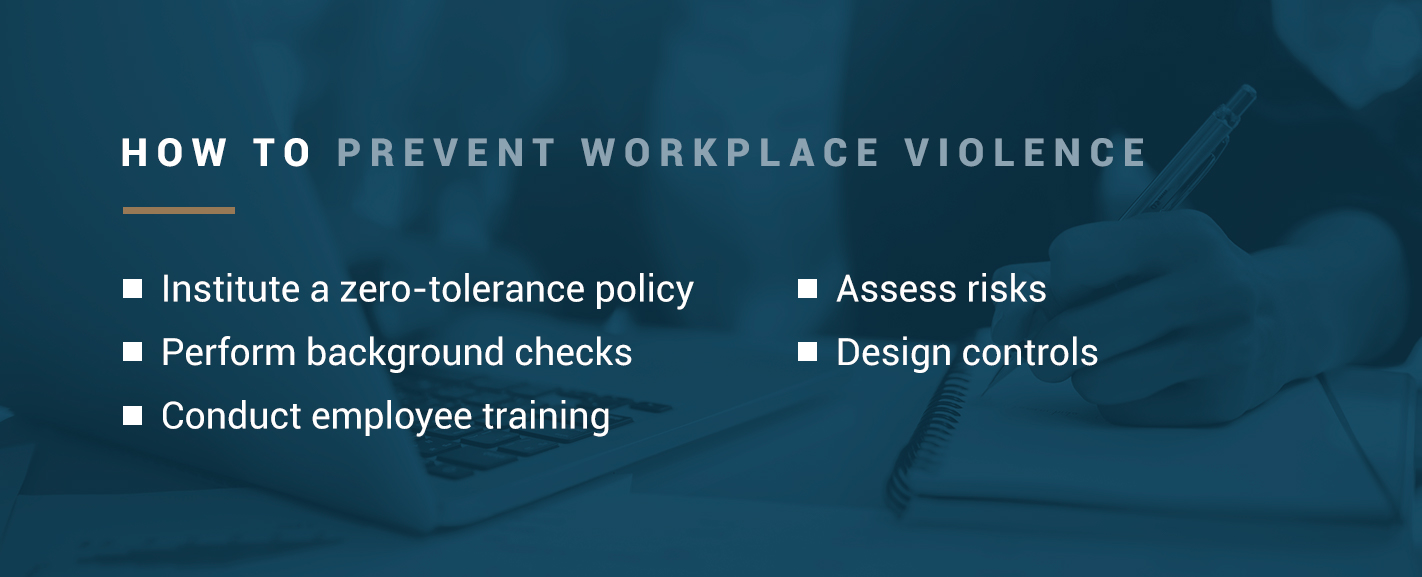Assessing Dangers: California Workplace Violence Prevention and Danger Management
Assessing Dangers: California Workplace Violence Prevention and Danger Management
Blog Article
The Vital Duty of Training and Recognition in Making Certain Efficient California Work Environment Violence Prevention Programs
In the world of office safety and security and protection, the value of carrying out robust physical violence prevention programs can not be overemphasized. Particularly in California, where strict guidelines demand a positive approach to protecting workers, the role of training and recognition emerges as a cornerstone of reliable prevention techniques. By delving right into the details of office physical violence dangers, establishing tailored training programs, cultivating a society of caution, and developing clear coverage and feedback methods, organizations can minimize prospective risks and safeguard their labor force. Nonetheless, real effectiveness of these programs lies not just in their production yet likewise in the ongoing evaluation of their impact and versatility to evolving risks.
Comprehending Office Violence Risks
In assessing office physical violence dangers, it is critical to thoroughly check out the details variables that add to potential threats within the organizational atmosphere. High-stress industries, such as health care and regulation enforcement, may have a greater threat of violence due to the psychologically charged scenarios workers come across.
Moreover, individual aspects, such as previous background of physical violence or chemical abuse concerns, can also play a significant role in enhancing the likelihood of office physical violence. It is necessary for organizations to perform comprehensive risk assessments that take right into account these various elements to create an extensive avoidance strategy. By determining and comprehending the specific risks present in the work environment, employers can proactively resolve prospective hazards and create a safer atmosphere for all workers.

Developing Worker Training Programs
Effective workplace violence avoidance programs call for the advancement of comprehensive staff member training programs tailored to the specific threats and requirements of the organization. These training programs ought to include different facets, consisting of recognizing early warning indicators of possible violence, de-escalation strategies, conflict resolution methods, and reporting treatments.
To start, it is vital to conduct a comprehensive risk evaluation to recognize the one-of-a-kind susceptabilities within the organization. This evaluation should inform the content and emphasis of the training programs, making sure that workers are equipped with the knowledge and skills necessary to stop and respond to possible threats successfully.
Additionally, training sessions ought to be appealing and interactive to optimize retention and application of the info provided. Making use of real-life circumstances and simulations can help staff members practice their reactions in a controlled atmosphere, improving their readiness in case of a crisis.
Regular support of training through refresher course training courses and updates is also crucial to make certain that workers stay watchful and aggressive in preserving a safe workplace. By purchasing well-designed and tailored training programs, organizations can empower their staff members to play an active function in protecting against workplace physical violence.
Promoting a Society of Understanding

Key to cultivating a culture of understanding is management buy-in and dedication to prioritizing the safety and health of all workers. Leaders need to establish the tone by regularly communicating the relevance of work environment safety and security, offering resources for training, and encouraging open dialogue about any kind of worries associated with work environment physical violence - california workplace violence prevention. Furthermore, organizations can implement awareness projects, such as e-newsletters, workshops, and posters, to maintain the subject at the center of staff members' minds
Applying Coverage and Feedback Treatments
To establish a robust structure for dealing with workplace violence cases, companies must establish reliable and clear reporting and action procedures. Reporting procedures must click here for info lay out how employees can report any prospective or actual physical violence, harassment, or endangering behavior. By carrying out thorough reporting and feedback procedures, companies demonstrate their commitment to preserving a secure and safe and secure office for all workers.
Reviewing Program Efficiency
Examining the impact and results of workplace violence avoidance programs is vital for companies to gauge the performance of their initiatives and make educated decisions regarding program enhancements. Analysis methods need to focus on measuring the program's capability to avoid and reduce occurrences of work environment physical violence, as well as the overall efficiency of training and understanding efforts.
Additionally, carrying out surveys or meetings with staff members can give beneficial insights into the viewed efficiency of the program and locations for enhancement. Comments from workers that have undertaken training or been involved in an office physical violence case can assist companies recognize strengths and weak points in their prevention initiatives - california workplace violence prevention. Frequently updating and examining program effectiveness metrics based upon analysis outcomes is critical for keeping a positive and efficient workplace physical violence prevention program in The golden state
Conclusion

Furthermore, individual variables, such as previous history of physical violence or material misuse concerns, can also play a considerable function in raising the chance of office physical violence. Leaders should set the tone by constantly connecting the importance of work environment security, supplying sources for training, and encouraging open discussion regarding any type of worries connected to work environment violence.Examining the influence and results of work environment violence prevention programs is vital for organizations to assess the effectiveness of their efforts and make educated choices pertaining to program improvements. Routinely assessing and upgrading program performance metrics based on evaluation results is critical for preserving a positive and efficient workplace violence avoidance program in California.
By recognizing the risks linked with work environment physical violence, creating training programs, advertising a culture of recognition, and consistently examining program efficiency, companies can create a much safer job environment for employees.
Report this page